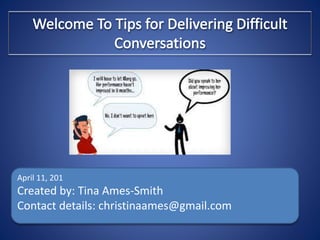
Tips For Delivering Difficult Conversations
- 1. April 11, 201 Created by: Tina Ames-Smith Contact details: christinaames@gmail.com
- 2. • This is safe and positive environment to share in. • Be respectful and courteous. •Please turn cell phones off /Silent. If you need to make or take a call please feel free to step outside of class to do so. • You may have drinks in class. •Please reframe from eating in the class. • Washroom breaks– feel free to step out when needed.
- 3. Agenda Introductions and Agenda Review Difficult conversations we encounter What to think about when preparing for difficult conversations Break – 20 Minutes Things to remember during difficult conversations Activity Break – 20 Minutes Top 6 mistakes that can turn difficult conversations into disasters. Closing Summary and Q&A
- 4. 1. Name 2. Role & Supporting Line of Business. 3. Say one word that comes to mind when you think of difficult conversations.
- 5. Having difficult conversations can be one of the most stressful and uncomfortable aspects of our lives and work. What are some types of difficult conversations you have encountered? How did you feel about having them?
- 6. Difficult conversations are never easy, so there are a few things you do to prepare and make an uncomfortable situation slightly less awkward. 1. Choose the right place to have the conversations • Talk privately - Preserve employees’ dignity and privacy by keeping delicate conversations behind closed doors. • Consider holding the meeting in a neutral place.
- 7. 2. Plan your approach with various reactions in mind. • Ask yourself questions such as, how might the person react to the conversation? • Consider how the person will react, then develop a few contingency plans. What kind of emotions or reactions can the person have? What would be some types of contingency plans you can put in place?
- 8. 3. Know your objectives What do you want to accomplish with the conversation? What are the desired outcome and action items? What are the non-negotiable? What is the support plan and follow up steps going to be?
- 9. How Would You Prepare and Approach? Activity Instructions: •Break out into assigned groups. • Review group assigned case study. • On flip Chart paper provided map out strategy for the following 3 points. • Where will you have the conversation? • What is your approach? • What are your objectives? List questions you would ask. • Each group will present approach. Objective: Practice preparing for difficult conversation.
- 10. 1. Go in with a inquiring mindset • Spend time to reflect on your attitude toward the situation and the person involved. • What are your preconceived notions about it? •Be open to hear what the person has to say, get clarity on the situation. Let them tell their story.
- 11. •A calm demeanor on your part can inspire confidence that you will handle the situation in a professional manner. • It also encourages the employee to calm down and better explain the circumstances. 2. Keep your emotions in check
- 12. •Some problem-solving can be done immediately, while other matters will take additional time or require the involvement of additional people. •Make sure the employee is aware of the process and understands expectations. •Follow up with the employee after the difficult conversation. Sometimes people have additional thoughts or questions after they have had time to process a discussion. 3. Determine Next Steps
- 13. Top 6 mistakes that can turn difficult conversations into disasters Going in with negative attitude. Avoiding the conversation. Responding to or reacting to emotional state. Delivering bad news via email. Trying to fill in the silence. Rushing to get it over with.
- 14. So.. When Getting Prepared For a Difficult Conversation Choose the right place to have the conversations. Plan your approach with various reactions in mind. Know your objectives.
- 15. Go in with a inquiring mindset. Keep your emotions in check. Determine next steps.
- 16. Difficult conversations often take a large mental and emotional toll on all participants. Being prepared and ready to take on the conversation is a skills that will be exercised throughout your career. Understanding support you have to help you through is key. What was one key thing you will bring to your next difficult conversation?
- 17. THANK YOU !